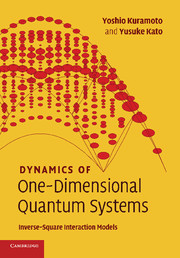Book contents
- Frontmatter
- Contents
- Preface
- 1 Introduction
- Part I Physical properties
- 2 Single-component Sutherland model
- 3 Multi-component Sutherland model
- 4 Spin chain with 1/r2 interactions
- 5 SU(K) spin chain
- 6 Supersymmetric t–J model with 1/r2 interaction
- Part II Mathematics related to 1/r2 systems
- Afterword
- References
- Index of symbols
- Index
4 - Spin chain with 1/r2 interactions
from Part I - Physical properties
Published online by Cambridge University Press: 12 January 2010
- Frontmatter
- Contents
- Preface
- 1 Introduction
- Part I Physical properties
- 2 Single-component Sutherland model
- 3 Multi-component Sutherland model
- 4 Spin chain with 1/r2 interactions
- 5 SU(K) spin chain
- 6 Supersymmetric t–J model with 1/r2 interaction
- Part II Mathematics related to 1/r2 systems
- Afterword
- References
- Index of symbols
- Index
Summary
In this chapter, we discuss the static and dynamic properties of the spin chain which is often referred to as the Haldane–Shastry model [77, 161]. In contrast with more familiar spin chains with the nearest-neighbor exchange interaction, the Haldane–Shastry model has a particular form of the longrange exchange interaction. In spite of its peculiar shape, it has turned out that the Haldane–Shastry model is the most fundamental one-dimensional spin system. We shall start with a discussion of how the model is solved for the ground state in Sections 4.1 to 4.3, and proceed to static correlation functions in Sections 4.4 and 4.5. The excitation spectrum is interpreted by magnons in Section 4.6, and by spinons in Section 4.7. The spinon picture gives the correct degeneracy of the energy levels in Section 4.8, and leads to the derivation of thermodynamics in Section 2.4, and the dynamical correlation function in Section 4.11. Most results have been obtained in an analytic form without any approximation.
There is a close connection between the spectrum of the spin chain and that of the Sutherland model. The most remarkable fact is that the spin chain has a correspondence with two different values of the coupling parameter λ in the Sutherland model. Namely, the spectrum is mapped to the case with either λ = 2 or λ = ∞. In the latter case, particles crystallize with equal spacing, and a small oscillation from the equilibrium, as well as exchange interactions, make up the spectrum. In both cases of λ, however, the degeneracy of each level in the spin chain is not reproduced. Hence, the mapping as it stands cannot be used for thermodynamics.
- Type
- Chapter
- Information
- Dynamics of One-Dimensional Quantum SystemsInverse-Square Interaction Models, pp. 150 - 219Publisher: Cambridge University PressPrint publication year: 2009

